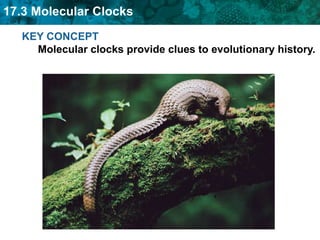Unit 17b Domains and kingdoms
•Als PPTX, PDF herunterladen•
1 gefällt mir•1,207 views
Melden
Teilen
Melden
Teilen

Empfohlen
Weitere ähnliche Inhalte
Was ist angesagt?
Was ist angesagt? (20)
Iczn(The International Commission on Zoological Nomenclature )

Iczn(The International Commission on Zoological Nomenclature )
Introduction to zoological nomenclature and the ICZN

Introduction to zoological nomenclature and the ICZN
Andere mochten auch
Andere mochten auch (20)
Unit 15a Habitat niche interactions and growth patterns

Unit 15a Habitat niche interactions and growth patterns
Unit 18a DNA fingerprinting and genetic engineering

Unit 18a DNA fingerprinting and genetic engineering
Unit 14a Relationships, biotic, and abiotic factors

Unit 14a Relationships, biotic, and abiotic factors
Ähnlich wie Unit 17b Domains and kingdoms
Ähnlich wie Unit 17b Domains and kingdoms (20)
Apologia Biology - updated Module 9 & 10 (bact virus) (protist fungi).pptx

Apologia Biology - updated Module 9 & 10 (bact virus) (protist fungi).pptx
What Are Archaea And Bacteria Be Classified As Two...

What Are Archaea And Bacteria Be Classified As Two...
Give several pieces of evidence that RNA preceded proteins and DNA in.pdf

Give several pieces of evidence that RNA preceded proteins and DNA in.pdf
Microbial Phylogenomics (EVE161) Class 3: Woese and the Tree of Life

Microbial Phylogenomics (EVE161) Class 3: Woese and the Tree of Life
Comparing The 18Th Century Physician And Botanist Linnaeus...

Comparing The 18Th Century Physician And Botanist Linnaeus...
Mehr von Olympus High School - Jeff Taylor
Mehr von Olympus High School - Jeff Taylor (19)
SDS Episode2 - The Habitat Requirements of Pacific Northwest Bats

SDS Episode2 - The Habitat Requirements of Pacific Northwest Bats
Unit 16a Resource consumption pollution and greenhouse effect

Unit 16a Resource consumption pollution and greenhouse effect
Unit 17b Domains and kingdoms
- 1. KEY CONCEPT Molecular clocks provide clues to evolutionary history.
- 2. Mutations add up at a fairly constant rate in the DNA of species that evolved from a common ancestor. Ten million years later— one mutation in each lineage Another ten million years later— one more mutation in each lineage Molecular clocks use mutations to estimate evolutionary time. Mutations add up at a constant rate in related species. This rate is the ticking of the molecular clock. As more time passes, there will be more mutations. The DNA sequences from two descendant species show mutations that have accumulated (black). The mutation rate of this sequence equals one mutation per ten million years. DNA sequence from a hypothetical ancestor
- 5. higher rate, better for studying closely related species
- 7. mutation rate ten times faster than nuclear DNA
- 11. Plantae Animalia Classification is always a work in progress. Why? The tree of life shows our most current understanding. New discoveries can lead to changes in classification. Until 1866: only two kingdoms,Animalia and Plantae
- 14. 1938: prokaryotes moved to kingdom Monera
- 15. 1959: fungi moved to own kingdomMonera
- 17. 1938: prokaryotes moved to kingdom Monera
- 18. 1959: fungi moved to own kingdom
- 21. one of largest groups on Earth
- 23. cell walls chemically different from bacteria
- 24. differences discovered by studying RNA
- 27. kingdom Protista
- 29. kingdom Protista
- 30. kingdom Plantae
- 32. kingdom Protista
- 33. kingdom Plantae
- 34. kingdom Fungi
- 36. transfer genes among themselves outside of reproduction
- 37. blurs the linebetween “species”
- 39. Which of the following is not a feature of a cladogram? A. nodes B. derived characters C.clades D.taxons Correct Answer = D What is true about two organisms that share the same common ancestor? A. They have no common derived characters. B. They are in the same clade. C. They are not closely related. D. They evolved at the same time.
- 40. Which of the following is not a feature of a cladogram? A. nodes B. derived characters C.clades D.taxons Correct Answer = D What is true about two organisms that share the same common ancestor? A. They have no common derived characters. B. They are in the same clade. C. They are not closely related. D. They evolved at the same time. Correct Answer = B
- 41. Review DNA mutations give clues to evolutionary time and relationships Nuclear DNA, mitochondrial DNA and ribosomal RNA mutate at different rates As scientific discoveries were made, the number of kingdoms changed and domains were added
